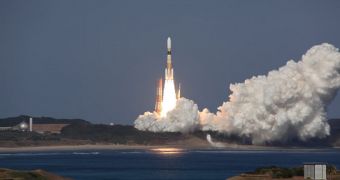Officials at the Japanese Aerospace Exploration Agency (JAXA) announce the successful launch of the Kounotori-2 H-II Transfer Vehicle (HTV2) unmanned cargo spacecraft. The resupply capsule is currently heading towards the International Space Station (ISS).
According to the official flight manifest, HTV2 is due to reach the international facility on January 27, after 5 days of playing catch in low-Earth orbit (LEO). Initially, the spacecraft was supposed to launch on January 20, and spend seven days in orbit, but that plan did not materialize.
Clouds over the Tanegashima Space Center in southern Japan forced mission controller to abort the launch attempt, and reschedule it for today, January 22, at 12:37 am EST (2:27 pm Japan time).
The H-IIB delivery system, constructed by JAXA and Mitsubishi Heavy Industries (MHI), blasted off from the space center at precisely the planned time, and managed to reach LEO successfully.
Shortly after, it delivered its payload, which is now set on a rendezvous course with the station. The may cargo aboard HTV2 is made up of scientific experiments, food, propellant, water and personal items for the six Expedition 26 crew members in space.
The cargo weighs more than 4 tons, Japanese officials have revealed. In charge of ensuring that the payload gets safely transferred on the ISS are flight engineers Catherine Coleman (NASA) and Paolo Nespoli (European Space Agency).
The two have been practicing grappling, retrieval and docking maneuvers with the Canadarm2 robotic arm on the ISS. Since the HTV spacecraft series has no automated docking systems, astronauts on the orbital facility basically need to fish the cargo capsules using the robotic handler.
During the first HTV mission to the station, astronauts had only 99 seconds to capture the spacecraft before it moved out of range. All signs point at a similar time frame for the new mission. After capture, Kounotori-2 will be docked to the Earth-facing port of the Harmony module.
The capsule will remain attached to the ISS until the end of March, when it will be filled with thrash and other debris, and deorbited above the Pacific Ocean. It will burn up upon reentering Earth's atmosphere, alongside all of its cargo.
With the American space shuttles scheduled to fly only three more flights, and with the ISS life span extended to at least 2020, the Japanese HTV and the European Automated Transfer Vehicle (ATV) will need to pick up some extra “chores.”
The Russian Federation cannot handle resupplying the ISS with the Soyuz and Progress capsules exclusively, and so the cargo that the shuttles carried will have to be split up, Space Fellowship reports.

 14 DAY TRIAL //
14 DAY TRIAL //